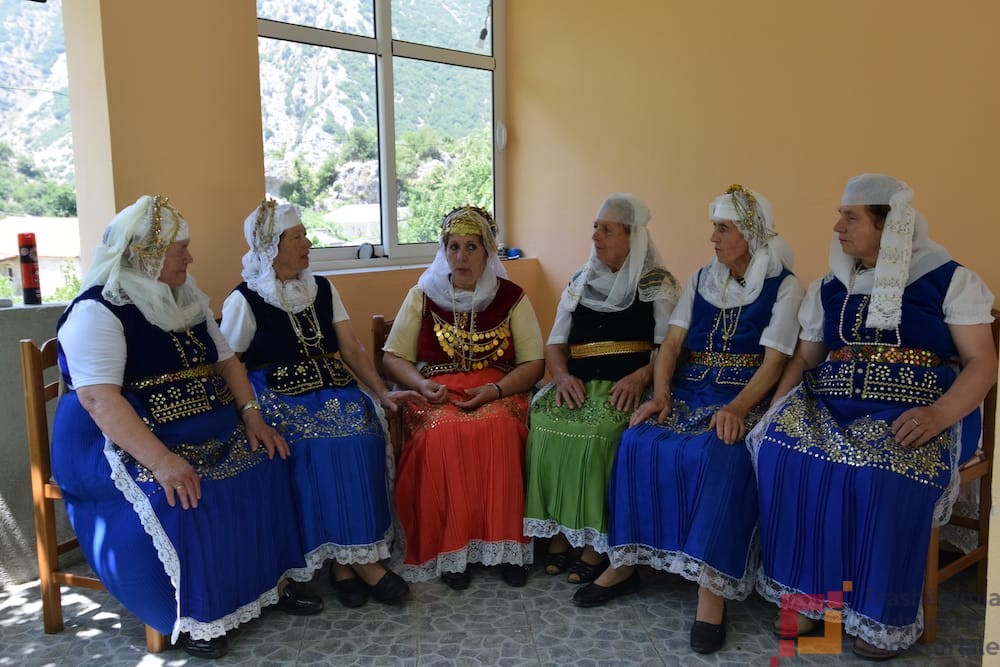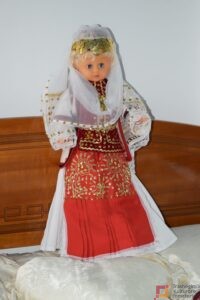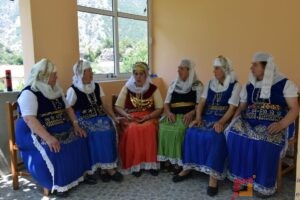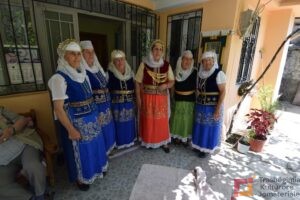“The Women Group of Selo Village” in Upper Dropulli is among the most long-lived polyphonic groups in Gjirokastra district. The members’ age of this group ranging from 60 to 75 years old, is the best testimony.
The polyphony of this captivating group has grabbed the attention of ethnomusicologists, not only because it is a constituent part of the Greek minority folklore, but because the songs these women have composed, bear very ancient motifs and are rich in typical elements, structures, and melodic patterns widely cultivated in this province.
Constituent parts of this mode of singing are; marrësi (the first soloist or taker), kthyesi (the second soloist or answerer), hedhësi (the third soloist or thrower), and iso part, which voices harmonically interlace in the melodic line, song-text, texture, and intricately feminine delicacy. Apart from certain minor variations, such structures, and flowing lines are performed and widespread across three provinces of the Greek minority in Gjirokastra – Upper Dropulli, Lower Dropulli, and Pogon.
In most of the musical performances, the polyphonic Women Group of Selo village comprises 8 traditional singers, but far earlier this number often went up to 10-12 singers, notably in cases where, in addition to isopolyphonic songs, their rendition was also accompanied by singing dance.
A typical song of the Selo Women Group starts quite plainly with the marrësi, continues synchronized with two-voice singing, adds to the kthyesi, and further progresses with three or four voices, which apart from the characteristic iso part, display a unique warbling throat voice of the hedhësi. The simple musical motif usually has a monostrophic structure from one verse to the next one, but in certain cases, a verse is accompanied by the refrain, which attaches to the first part or marrësi to be repeated verse after verse.
The women of Selo village do not only sing in musical performances, but also in family events such as weddings, engagements, birthdays, and religious celebrations like name days, saint days, and baptisms. Their repertoire involves songs of kurbet (emigration), bravery, ballads, lamentation, etc. The “lead” singer and the one with a central position in the group is called Vasiliqi Biçuni – 65 years old. Other names include Katina Ruxho – 72 years old, who is also the costume designer of the group, Sofia Zaho 71 years old, Stavrulla Kicaqi 70 years old, Valentina Ruxho 60 years old, Anastasia Kali 73 years old, Elefteria Grinja 75 years old and Marjanthi Agora 69 years old.
The Women Group of Sotira village is a rare cultural value of this province, which perfectly represents it and is in full harmony with the other heritage values of this village, the ancient ruins of Mulliri (Mill) and Kalaja e Selos (Castle of Selo), the arched Ura e Vjetër (Old Bridge) and the beautiful Kisha e Shën Thanasit (St. Thanas Church) of this village.
The Selo village women have been decently represented in many local and national folklore festivals, international events, local activities, rituals, and various celebrations in the village. They constantly perform dressed in the typical traditional costume of Dropulli woman, a strong blue costume, other than the bride’s one which comes in a more festive look and lighter colors. This costume reflects members’ age and seriousness and is fanatically preserved by these artists.
This is also one of the most actively engaged polyphonic groups on stage and outdoors with dozens of musical performances: in Albania – Gjirokastra, Vlora, Përmeti, and Tirana; in Greece – Ioannina, Konica, Agrinio, and Athens; and also many other musical performances in the Balkans – North Macedonia, Montenegro, and Serbia. Oxhup, which is made from a piece of dark velvet and plushy fabric along the dividing line of platforms. It is thick and lined, worn in winter to protect from the cold.
Once the costume has been designed and sewn, it is put on a dummy or something similar to check its fit, its look and to spot any possible defects.
Regarding the artisanal production of sashes, necklaces, and sheshëla-s, a top priority remains to preserve their originality to the most significant extent possible.
Making the women’s traditional costume takes almost two months.





